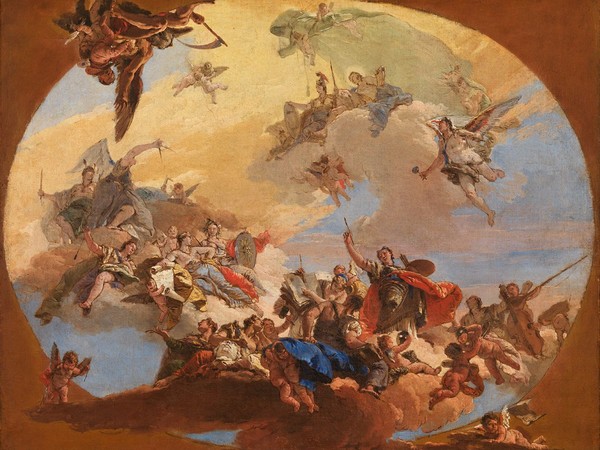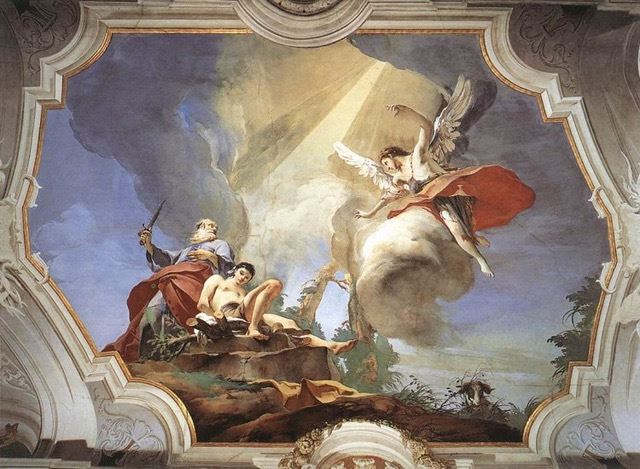To commemorate the 250th anniversary of Giambattista Tiepolo’s death (Venice 1696 - Madrid 1770), the first dedicated exhibition in Milan is now being staged. The exhibition, under the High Patronage of the Italian President of the Republic and in partnership with the Gallerie dell’Accademia of Venice, presents around seventy works by Tiepolo and his most important peers (including the Venetian artists Antonio Pellegrini, Giovanni Battista Piazzetta and Sebastiano Ricci as well as Lombardy-born Paolo Pagani) to trace the artistic career of the Venetian maestro, and his main patrons in the cities where he achieved his success: Venice, Milan, Dresden and Madrid.
THE EXHIBITION:
In the logical and concise exhibition path designed by the curators to help track Tiepolo’s international success - from his years of apprenticeship in Venice to his consecration within the major European courts - extraordinary masterpieces are revealed. These range from the youthful mythological creations of the Gallerie dell’Accademia of Venice to the Martyrdom of St. Bartholomew, painted in 1722 for the San Stae church in Venice (a true museum of early eighteenth-century Venetian art), displayed alongside the Martyrdom of St. James by Piazzetta (a contemporary work completed for the same location).
The vast series of paintings for Venetian palaces commissioned by ambitious and newly-ennobled families such as the Sandi and Zenobio households, sealed Tiepolo’s early success, as he proved able to mastermind works with many figures and recreate ancient tales with fantasy and flair.
On separate occasions (1730-1731, 1737 and 1740), Milan proved to be the first stop on his route to international success: the exhibition allows us to admire a series of works restored for the occasion, which are normally rarely or not at all available for public viewing, including the frescoes of the Basilica of Sant’Ambrogio and the fresco created for Palazzo Gallarati Scotti. The two removed frescoes that were created for the Sant’Ambrogio church present holy events in the epic style of this renowned history painter, while the allegory from Palazzo Gallarati Scotti reveals the fluid spatial illusion that would become a recurring theme in his works.
It will be possible to follow the preparatory process of the fresco for the Galleria on the piano nobile of Palazzo Clerici, thanks to some drawings and a wonderful sketch on loan from the Kimbell Art Museum of Fort Worth (United States).
Tiepolo's German output includes a sketch for a drawing room for the Würzburg family residence (based in Stuttgart), and a freehand interpretation of a work designed, in agreement with his friend Francesco Algarotti, for the Elector of Saxony and king of Poland, Augustus III: the Banquet of Antony and Cleopatra, here visible in the version from the National Gallery of London.
The years in Germany and Spain produced a close working relationship between Tiepolo and his sons, especially Giandomenico: the exhibition closes with a symbolic ‘showdown’ between father and son, with St. Francis of Assisi receiving the stigmata by Tiepolo senior from the Museo del Prado on one side and Abraham and the Three Angels from Gallerie dell’Accademia of Venice, by Giandomenico on the other.
Giovanni Battista Tiepolo (1696 - 1770), Cacciatore a cavallo, 1718, Olio su tela, 262 x 148 cm , Fondazione Cariplo

Giambattista Tiepolo, Trionfo delle arti e delle scienze, 1731 circa, Olio su tela, 55.5 x 72 cm, Lisbona, Museu Nacional de Arte Antiga | © MNAA/DGPC/ADF, Luísa Oliveira
The exhibition offers the chance to admire a series of works restored for the event: Apollo flaying Marsyas, Hercules suffocating Antaeus, Ulysses discovering Achilles among the daughters of Lycomedes, The Triumph of Virtue and Nobility over Ignorance, The Martyrdom of St. Victor, The Shipwreck of St. Satyrus by Giambattista Tiepolo; Spartacus leading the slaves' uprising by Antonio Pellegrini; Bacchus and Ariadne and The Contest of Apollo and Pan judged by King Midas by Sebastiano Ricci.
THE SECTIONS:
1. The first section, The cities of Tiepolo: Venice, Milan, Madrid - figuratively summarises the places that played a part in the life and fortunes of Tiepolo, providing a birds-eye view of the eighteenth century, an era of international success for Italian artists. In the first half of the eighteenth century, Venice was perhaps themost beloved city in Europe for its artists, beginning with the ‘vedutista’ group, the city-scape painters: these included Canaletto and Bellotto along with Antonio Joli, an artist who studied in Rome and was influenced by the work of Gaspar van Wittel.
2. The next section focuses on Academy studies of nudes in Venice. Sketching nudes is a fundamental part of training for artists all over Europe, especially since the academies started to favour this drawing exercise in the seventeenth century. Venice became a centre which made this particular type of exercise its own, enlivened by the presence of many foreign artists with whom Tiepolo exchanged ideas, drawing and painting his own first independent works.
3. In the third section, closely connected to the previous element, The beginnings of Tiepolo betwixt Pagani, Pellegrini and Piazzetta takes different perspectives on the inspiration Tiepolo drew from his contemporaries.
4. The exhibition then arrives at Early success in Venice. History and mythology on the wings of fantasy. Here, the main elements of two periods of work in Venice for the Sandi and Zenobio families, are emblematically represented. Tiepolo started to creatively conjure up mythological and historical stories with an incredible skill in orchestration and free interpretation; the key to his success in Europe would be as a wonderful storyteller at the service of his patrons for their own glorification.
5. The fifth section of the exhibition looks at Venice and Milan, a backstory: Sebastiano Ricci. Milan and Venice share a special relationship, with Milan representing the first step to international success for many Venetian artists: this was the case for Tiepolo and Bellotto, as it had been some time earlier for Sebastiano Ricci.
6. The sixth section, Tiepolo in Milan: the first step to international success, revolves around the complex network of relationships that allowed Tiepolo to enjoy success in Milan in two important moments of his career. The artist’s choices in many frescoes of the city allow us to trace, through a succession of drawings and sketches, his modus operandi and ability to offer solutions that were increasingly spacious and airy, as well as increasingly spectacular. These solutions include his work in Palazzo Clerici, practically a forerunner to what the painter would complete some years later in Würzburg and Madrid.
7. Between 1751 and 1753, Tiepolo moved to Würzburg in Germany, with his children. The section Tiepolo and Germany focuses on how Giandomenico (by now, the famous maestro’s travel companion) had begun to work alongside his father. In this context, Tiepolo’s time in Würzburg is traced via a preparatory sketch for the fresco and his version of the Banquet of Antony and Cleopatra, a theme much-loved by the court of Dresden (one of the most modern artistic centres of that time in Europe) where he was enthusiastically welcomed and acclaimed in a career orchestrated by Francesco Algarotti.
8. The last stage in Giambattista’s life, as encapsulated in Tiepolo and his children in Spain, was marked by an increasingly close relationship with his children who would then follow him to Madrid, remaining there after his death. Challenged by Giandomenico’s emerging talent, Gianbattista Tiepolo was led to make new stylistic choices, marked by an unusually expressive tenderness, an air of melancholic introspection, withrepercussions in the softer brushstrokes, and in the more meticulous and less resentful drawing. This final stage in the story of Tiepolo is particularly evocative and marked by only a few works, with father and son being symbolically placed head-to-head in the field of Character Heads, a very popular genre with international audiences.
BIOGRAPHICAL NOTES:
Giambattista Tiepolo first visited the Republic of Venice in 1715, benefiting from a particular historicalpolitical climate that kept Venice safe from European turbolence for almost a century, while guaranteeing a proliferation of art and literature. A contemporary of Canaletto, Tiepolo understood how to win favour with the clergy and Venetian aristocracy, decorating churches and palaces with his artwork on canvas and frescoes - allegorical, mythological and holy themes, richly theatrical and magnificent.
Tiepolo’s greatness, which would make him one of the most acclaimed and sought-after artists of his time (and, in a certain sense, a forerunner of Enlightenment) can be attributed to his capacity for observation of nature. Indeed, nature became his main source of inspiration, of his unlimited narrative flair and expert skill in the use of colours, light and perspective.
His success took him to Milan, ruled by the Hasburgs, where he and Sebastiano Ricci revolutionised the art scene. Tiepolo developed a freedom of expression and an extraordinary skill in orchestrating grandiose compositions consisting of hundreds of figures in series of frescoes for the palazzi Archinto, Casati, Clerici and Gallarati Scotti as well as at the Basilica of Sant’Ambrogio.
Launched to the top of the international art scene, he would become an artist sought-after in all the major European courts. He enjoyed a strong relationship with Germany, struck up in the 1730s, particularly with the court of Dresden where his philosopher, intellectual and connoisseur friend Francesco Algarotti, his avid supporter and admirer, acted as a diplomat for Augustus III (Elector of Saxony and King of Poland).
The painter’s success in Germany led him to settle between 1751 and 1753 in Würzburg, capital of Franconia, where he created the artwork for prince-bishop Carl Phillip von Greiffenclau’s official residence. From the 1760s until his death in 1770, he lived in Spain, under the patronage of King Charles III (Charles Bourbon). In Madrid he decorated the vast areas of the royal palace and later remained at the Bourbon court as an altarpiece painter.
His posthumous reputation was subject to a slow decline until he was again revalued by Francesco Hayez almost a century later - in fact, it was Hayez who was responsible for the rediscovery of Tiepolo, slightly earlier than collector Edward Cheney who stayed in Venice in the 1840s and managed to purchase a large number of magnificent oil sketches and various drawing books.

